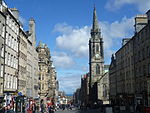Burning of Edinburgh
1544 in Scotland16th-century fires16th-century military history of ScotlandAmphibious operations involving the United KingdomBurned buildings and structures in the United Kingdom ... and 12 more
Conflicts in 1544Disasters in EdinburghEdinburgh CastleFires in ScotlandHistory of EdinburghLootingMary, Queen of ScotsRough WooingSieges involving EnglandSieges involving ScotlandUrban fires in the United KingdomUse British English from December 2012
The Burning of Edinburgh in 1544 by an English sea-borne army was the first major action of the war of the Rough Wooing. A Scottish army observed the landing on 3 May 1544 but did not engage with the English force. The Provost of Edinburgh was compelled to allow the English to sack Leith and Edinburgh, and the city was burnt on 7 May. However, the Scottish artillery within Edinburgh Castle harassed the English forces, who had neither the time nor the resources to besiege the Castle. The English fleet sailed away loaded with captured goods, and with two ships that had belonged to James V of Scotland.
Excerpt from the Wikipedia article Burning of Edinburgh (License: CC BY-SA 3.0, Authors).Burning of Edinburgh
Boyd's Entry, City of Edinburgh Canongate
Geographical coordinates (GPS) Address Nearby Places Show on map
Geographical coordinates (GPS)
| Latitude | Longitude |
|---|---|
| N 55.95 ° | E -3.1833333333333 ° |
Address
Boyd's Entry 4
EH1 1SY City of Edinburgh, Canongate
Scotland, United Kingdom
Open on Google Maps










